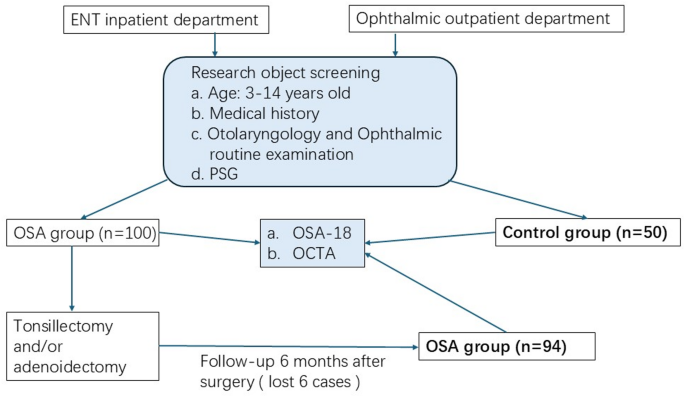General data
Six OSA children fell off at follow-up 6 months after surgery. Therefore, this study was finally included in the OSA group 94 children (male 46, female 48) and 50 healthy control group (male 25, female 25). There was no statistically significant difference in the age (6.95 ± 2.10 vs. 6.82 ± 2.12, P = 0.731), gender ratio (chi-square = 0.123a, P = 0.861) between the OSA group and the control group.
Comparison of OSA-18 (Table 1; Fig. 2A)
Comparison of observational indicators.
Through t-tests, we found that the OSA-18 scores of children in the OSA group before surgery were higher than those in the control group, and the difference was statistically significant (72.532 ± 12.865 vs. 29.220 ± 6.911, P < 0.0001). However, at the six-month follow-up after surgery, the OSA-18 scores of children in the OSA group were lower than before surgery (31.096 ± 9.340 vs. 72.532 ± 12.865, P < 0.0001), and had fallen to the same level as those in the control group (31.096 ± 9.340 vs. 29.220 ± 6.911, P > 0.05).
Comparison of VLD (Table 1; Fig. 2B and E)
Through t-tests, we found that the VLD1 in the OSA group before surgery was lower than those in the control group, and the difference was statistically significant (9.541 ± 0.183 vs. 9.615 ± 0.098, corrected P = 0.008). However, at the six-month follow-up after surgery, the VLD1 of children in the OSA group were higher than before surgery (9.625 ± 0.142 vs. 9.541 ± 0.183, P = 0.001), and had increased to the same level as those in the control group (9.625 ± 0.142 vs. 9.615 ± 0.098, corrected P = 0.671).
VLD2 showed a consistent trend with VLD1, with preoperative VLD2 values in the OSA group being lower than those in the control group, a difference that was statistically significant (17.951 ± 0.131 vs. 18.821 ± 0.146, corrected P < 0.0001). However, at 6 months postoperatively, VLD2 values in the OSA group were significantly higher than preoperative levels (18.852 ± 0.131 vs. 17.951 ± 0.131, P < 0.0001), returning to the same level as those in the control group (18.852 ± 0.131 vs. 18.821 ± 0.146, corrected P = 0.213).
Through t-tests, no statistical difference was found between the preoperative VLD3 of OSA patients and the control group (18.399 ± 0.087 vs. 18.383 ± 0.093, corrected P = 0.282). Six months after surgery, the VLD3 values of OSA children did not change significantly compared with those before surgery (18.381 ± 0.088 vs. 18.399 ± 0.087, P = 0.167), and there was no significant difference compared with the control group (18.381 ± 0.088 vs. 18.383 ± 0.093, corrected P = 0.945).
VLD4 showed a consistent trend with VLD3, which no statistical difference was found between the preoperative VLD4 of OSA patients and the control group (18.162 ± 0.076 vs. 18.173 ± 0.070, corrected P = 0.410). Six months after surgery, the VLD4 values of OSA children did not change significantly compared with those before surgery (18.162 ± 0.071 vs. 18.162 ± 0.076, P = 0.953), and there was no significant difference compared with the control group (18.162 ± 0.071 vs. 18.173 ± 0.070, corrected P = 0.384).
Comparison of VPD (Table 1; Fig. 2F and I)
Through t-tests, we found that the VPD1 in the OSA group before surgery was lower than those in the control group, and the difference was statistically significant (0.247 ± 0.044 vs. 0.409 ± 0.027, corrected P < 0.0001). However, at the six-month follow-up after surgery, the VPD1 of children in the OSA group were higher than before surgery (0.399 ± 0.029 vs. 0.247 ± 0.044, P < 0.0001), and had increased to the same level as those in the control group (0.399 ± 0.029 vs. 0.409 ± 0.027, corrected P = 0.054).
VPD2 showed a consistent trend with VPD1, with preoperative VPD2 values in the OSA group being lower than those in the control group, a difference that was statistically significant (0.406 ± 0.028 vs. 0.429 ± 0.027, corrected P < 0.0001). However, at 6 months postoperatively, VPD2 values in the OSA group were significantly higher than preoperative levels (0.437 ± 0.030 vs. 0.406 ± 0.028, P < 0.0001), returning to the same level as those in the control group (0.437 ± 0.030 vs. 0.429 ± 0.027, corrected P = 0.100).
Through t-tests, no statistical difference was found between the preoperative VPD3 of OSA patients and the control group (0.453 ± 0.027 vs. 0.449 ± 0.013, corrected P = 0.291). Six months after surgery, the VPD3 values of OSA children did not change significantly compared with those before surgery (0.450 ± 0.015 vs. 0.453 ± 0.027, P = 0.364), and there was no significant difference compared with the control group (0.450 ± 0.015 vs. 0.449 ± 0.013, corrected P = 0.547).
VPD4 showed a consistent trend with VPD3, which no statistical difference was found between the preoperative VPD4 of OSA patients and the control group (0.372 ± 0.065 vs. 0.389 ± 0.067, corrected P = 0.131). Six months after surgery, the VPD4 values of OSA children did not change significantly compared with those before surgery (0.383 ± 0.066 vs. 0.372 ± 0.065, P = 0.256), and there was no significant difference compared with the control group (0.383 ± 0.066 vs. 0.389 ± 0.067, corrected P = 0.590).
Comparison of FAZ (Table 1; Fig. 2J)
Through t-tests, no statistical difference was found between the preoperative FAZ of OSA patients and the control group (0.277 ± 0.018 vs. 0.274 ± 0.013, corrected P = 0.363). Six months after surgery, the FAZ values of OSA children did not change significantly compared with those before surgery (0.273 ± 0.018 vs. 0.277 ± 0.018, P = 0.125), and there was no significant difference compared with the control group (0.273 ± 0.018 vs. 0.274 ± 0.013, corrected P = 0.639).
